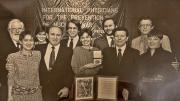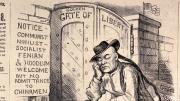
Image courtesy of Harvard Law School

Image courtesy of Harvard Law School
True-crime fans, rejoice! A new website puts up virtual shelves of murder and mayhem for your reading pleasure. “Dying Speeches and Bloody Murders: Crime Broadsides Collected by the Harvard Law School Library” may be found at https://broadsides.law.harvard.edu.

Image courtesy of Harvard Law School
At public executions in eighteenth- and nineteenth-century Britain, hawkers sold, usually for a penny, single-sheet guides to the event, much like a program at a football game today. These broadsides, known generically as “dying speeches” or “bloody murders,” luridly described the criminal and his or her villainy and comeuppance, often including pious verse. The example at right, from 1836, is typical. It tells of Margaret Joyer and Katharine Rentner, who poisoned many of their near relatives. They might have gotten away with it, but a specter appeared to Joyer and so terrified her that she confessed. Because she had murdered her parents, her right hand was cut off before she was hanged.
The etching at top was made for street sale with a broadside about the case of Captain William Moir. Hot-tempered, he shot and killed a trespassing fisherman. The law school’s collection also includes such ephemera as God’s Revenge Against Murder, a short-lived true-crime periodical (above, middle).
One could be put to death in Britain at the time for a wide range of acts, in-cluding attempted murder, rape, arson, robbery, house-breaking, and counterfeiting. James Pratt and John Smith were “launched into eternity, amidst the yells & groans of the spectators,” for committing “an unnatural crime.”
Gentle readers who find this material disheartening are not the first to do so. The law school began collecting “dying speeches” in 1932 when it acquired a scrapbook of 280 of them compiled by one “G.S.” in England about 90 years earlier. G.S. wrote in an introduction that he made the scrapbook to demonstrate the barbarity of public executions. Indeed, it was time, he passionately declared, to entirely abolish “the Punishment of Death!”







